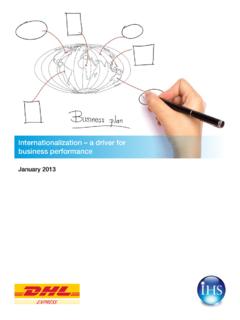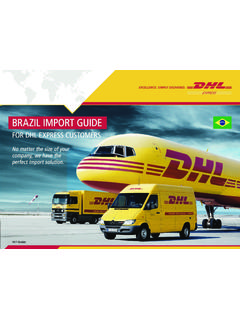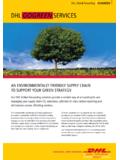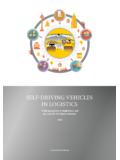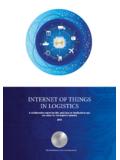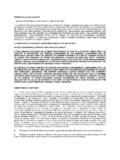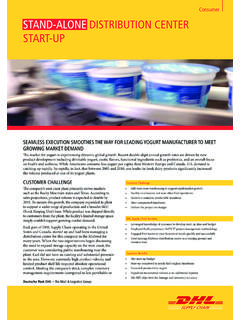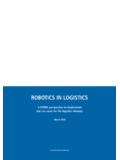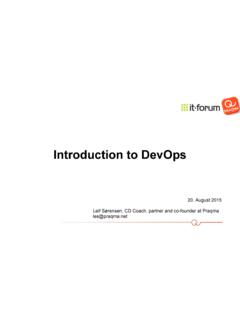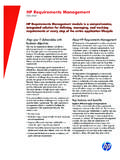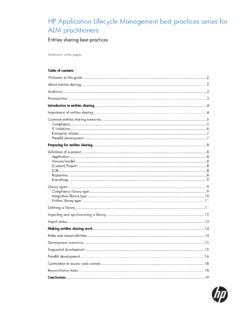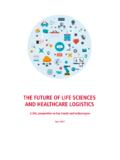Transcription of LOW-COST SENSOR TECHNOLOGY - DHL Express
1 LOW-COST SENSOR TECHNOLOGYA DHL perspective on implications and use cases for the logistics industryDecember 2013 Powered by Solutions & Innovation: Trend ResearchPUBLISHERDHL Customer Solutions & Innovation Represented by Martin Wegner Vice President Solutions & Innovation 53844 Troisdorf, GermanyPROJECT DIRECTOR Dr. Markus K ckelhaus Solutions & Innovation, DHL PROJECT MANAGEMENT AND EDITORIAL OFFICE Sven Steck & Fabian OrtmannSolutions & Innovation, DHLIN COOPERATION WITH:Prof. Klaus Richter, Olaf Poenicke1 One day, we may dispatch a fleet of transport vehicles with a simple wave of our hand. We may gather all the informa-tion required about the contents of a cargo container with just one brief electronic glance. And before long, we may be wearing our computers on our may sound like the stuff of science fiction, but it is fast-approaching reality, and it is likely to have significant impact on the logistics industry.
2 In this trend report, we take a deep dive into the enabler of this impact: LOW-COST SENSOR technologies that were first developed in the consumer world and are now moving into the business world. The potential for low- cost sensors in the logistics industry has already been highlighted in the acclaimed DHL Logistics Trend Radar , an overarching study and a dynamic, living document designed to help organizations derive new strategies and develop more powerful projects and logistics industry is often criticized for lack of inno-vation. The usual roadblock to innovation is expense, as it is very costly to trial new technologies across what is such a highly networked industry. Here then is an exciting opportunity the chance to innovate using LOW-COST sensors that have already proved their worth in the consumer environment. This trend report starts by recognizing the phenomenon and powerful benefits of consumerization, including the blurring of consumer/corporate boundaries as we use smartphones, tablet computers, and other mobile devices both at home and at logistics, we aim to get the right object, at the right time, in the right place, in the right quantity, in the right condition, and at the right (low) cost .
3 We can do this with LOW-COST sensors, and achieve the new levels of transparency that today s customer you will read in this trend report, the DHL Solutions & Innovation team is busy creating and piloting systems based on LOW-COST SENSOR TECHNOLOGY . Our next step is to bring these systems to market. We hope you enjoy this deep dive into the future of logistics. Yours sincerely,PrefacePREFACEM artin Wegner Dr. Markus K ckelhaus 22 Preface .. 1 Introduction and Executive Summary .. 31 Consumer Electronics: Trends .. 5 Consumerization and BYOD: Changing User Expectations .. 5 Mobile Computing: Toward the Internet of Things .. 6 SENSOR Technologies: Everything Gets Measured .. 7 Wearable Computers: Innovative Human-Machine Interfaces .. 8 Mobile Communication: Toward 5G .. 9 Distributed Data Management: Clouds and Big Data.
4 10 Business Apps: Speeding Up Innovation Cycles .. 102 Potential Application of LOW-COST Sensors in Logistics .. 11 Smartphone and Tablet Applications .. 12 Range Imaging SENSOR Systems .. 14 Smart Glasses and Smart Watch Applications .. 153 Field Test: Volume Scanning Using LOW-COST 3D Sensors .. 16 Need for Innovation .. 16 Prototyped Solutions and Findings .. 16 Remaining Challenges .. 18 Summary and Outlook .. 19 Sources .. 20 Table of Contents3 Introduction and Executive SummaryOne of the major current trends in the IT sector is the increasing integration of consumer IT devices in the business world. The buzzword for this is consumerization the growing phenomenon of leading IT solutions appearing first on the consumer market and subsequently spreading to business and industry. TECHNOLOGY leadership has shifted from serving companies to now serving individual consumers.
5 And the emergence of mobile computing technologies in particular, smartphones and tablet computers has resulted in employees being technically better equipped in their personal lives than in their professional world (Bitkom 2012).Approaches such as BYOD (bring your own device) constitute a first step toward the integration of consumer IT into business and industrial applications. Geared toward the professional use of personal devices (such as smartphones and tablets), BYOD integration has mainly focused on office-related applications such as email, word processing, and telecommunications. Moving beyond this, the consumer sector is now experiencing exciting new developments with innovative SENSOR technologies, particularly LOW-COST sensors. This consumer-led pheno-menon has great potential for business and industry, and for the development of new mobile devices.
6 The challenge for IT departments will be to integrate these new techno-logies as they spread from the consumer environment into the business trend report provides an overview of the LOW-COST SENSOR technologies and consumer electronics TECHNOLOGY trends that have relevance for the logistics industry. It systematically identifies the SENSOR and IT solutions capable of impacting logistics applications, and discusses their potential utilization in the logistics industry, as well as the challenges that they are likely to findings of this report indicate seven key ideas about the future utilization of consumer electronics in the logistics sector:1. Consumer electronics are changing user behavior in personal and professional environments2. Consumer electronics integrate customers as active partners in the processing of logistics orders3. Consumer electronics will advance the utilization of auto-ID technologies in logistics applications both for logistics companies and for customers4.
7 Consumer electronics in the form of wearable computers will be essential to personnel working in logistics companies5. Consumer electronics provide the human-machine interface for the Internet of Things and consecutive stages such as the Tactile Internet6. Consumer electronics enable and support seamless, real-time monitoring of logistics processes7. Consumer electronics enable and support seamless, real-time control of logistics processesINTRODUCTION AND EXECUTIVE SUMMARY LOW-COST SENSOR TECHNOLOGY is defined in this trend report as SENSOR TECHNOLOGY originally developed for consumer applications. Competitive and low cost because of economies of scale, these SENSOR technologies enable new applications or allow more cost -effective utilization of sensing in production and logistics processes and trend report follows three steps:Section 1: A brief review of the most important trends in consumer electronics, analyzing hardware and software trendsSection 2: Identifying key challenges to the integration of these innovative SENSOR technologies and IT solutions in business applicationsSection 3: Identifying implications for the logistics industry, and considering next stepsIntroduction and Executive SummaryFrom Trends to Use Cases to Model ApplicationConsu- merization & BYODM obile ComputingSensor TechnologiesWearable ComputingMobile CommunicationDecentralizedData ManagementBusiness Apps1.
8 Consumer Electronics TrendsSmartphone and Tablet Applications Scanning of Freight Image Documentation Order Management Navigation 3D Imaging Volume Measurement Capacity Monitoring Freight Fingerprint Automation Control Gesture ControlRange Imaging SENSOR Systems Pick-by-Vision AR-based Process Wearable Computing AppsSmart Glasses and Watch Applications2. Use Cases and Potential Applications in Logistics3. Field Test: Volume Scanning Using LOW-COST 3D SensorsRemaining ChallengesNeed for InnovationPrototyped Solutions and Findings5 Consumer Electronics: TrendsDevelopments in the consumer electronics market are characterized by short innovation cycles and low prices generated by economies of scale. Of course, these quali-ties are highly attractive to companies too, particularly organizations under competitive pressure to be agile and cut solutions first become familiar to people in their personal lives and then become relevant for professional use.
9 This is why the latest leading infor-mation and communication technologies (ICTs) tradi-tionally anchored in the business world are now being applied to the consumer market. Application domains previously restricted to the business world are increasingly being driven by consumer developments examples include augmented reality, gesture control, and 3D printing, to name but a electronics TECHNOLOGY trends are, of course, a subset of overall TECHNOLOGY development, which is generally expected to narrow the divide between humans and machines. According to Gartner s latest Hype Cycle, the relationship between humans and machines is at the heart of the increased hype surrounding smart machines, cognitive computing, and the Internet of Things (Gartner 2013a).Along with mobile computing devices such as smart- phones and tablets, emerging SENSOR technologies that were originally developed for consumer electronics such as gaming consoles are becoming relevant for business and industrial application.
10 And predictably, these consumer SENSOR technologies cost significantly less than industrial SENSOR section briefly reviews the consumer electronics trends with potential relevance for the logistics industry. Consumerization and BYOD: Changing User Expectations I think there is a world market for maybe five computers are the words allegedly said by Thomas J. Watson, former CEO of IBM, back in 1943 (Roland Berger 2011). He has since been proved wrong. Nevertheless for a very long time computer technologies were reserved for applications in the corporate world; businesses have always had the best IT available on the market. Today, things are , technical leadership evidenced by innovative hardware such as smartphones and tablet computers, as well as distributed software solutions such as cloud applications is likely to be located in the consumer world.
